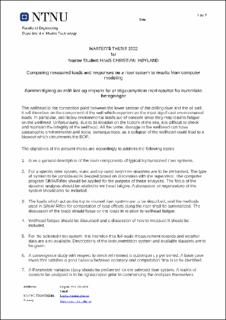| dc.description.abstract | This report considers loads on a subsea wellhead, with a focus on wellhead fatigue. The basis of the report is a drilling campaign committed by Equinor, from which Equinor has provided measurements of wellhead moment and related parameters throughout the campaign. The drilling campaign was operated by a top tensioned riser system. A detailed model of the riser system has been made in SIMA/RIFLEX. Time domain dynamic analysis has been utilized on the model, as well as eigenvalue analysis.
The wellhead moment calculated in the SIMA/RIFLEX model has been compared with the direct measurements of wellhead moment. The results shows that the eigenmodes are highly important in relation to the moment experienced on the wellhead. They also show that the RIFLEX model were conservative in relation to predicting the oscillating wellhead moment, and it was highly accurate in relation to predicting the oscillatory periods that excited the riser system. The model was however too conservative in regards to damping.
Indirect measures of wellhead moment has also been investigated. A quasi-static model has been presented, and the resulting wellhead moment has also been compared to the direct measurement of wellhead fatigue. The initial quasi-static model was non-conservative, but using higher than originally anticipated values for top tension on the wellhead, gave results with very high accuracy. It was also shown, as previous papers have indicated, that rotational angles on the BOP is a better indirect measure of wellhead moment than displacement on the top of the BOP. | |
